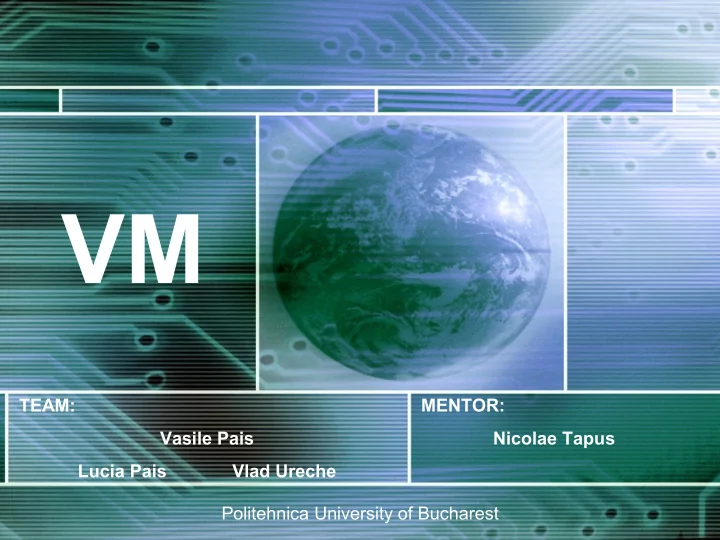

VM TEAM: MENTOR: Vasile Pais Nicolae Tapus Lucia Pais Vlad Ureche Politehnica University of Bucharest
Overview Project Purpose Facts and Figures Necessity Our Solution System Architecture Utility Further Development Conclusions
Project Purpose VM is meant to simulate electronic devices on a PC, enabling students to interact with them Students can create complex systems by simply connecting different parts It can interface with other real world devices
Facts and Figures Many electronics are unavailable or unaffordable for students AT32AP7000 (Atmel 32-bit RISC microcontroller) costs 53$ according to Froogle, but surpasses 100$ a piece in Romania usually a minimum quantity is imposed on electronic components order and delivery time for electronics slows down the project
Necessity Enables people to work with devices that otherwise they couldn’t afford Helps in the education process by allowing students to : • develop software for different architectures • simulate the electronic parts needed for lab data processing • gain thorough understanding of how the system works by inspecting the system’s internal state Allows continuous software testing (by simulation) before the prototype hardware is available
Our Solution VM Web Site Web Service Controls the Virtual Machines VNC Virtual Machines `
Our Solution VM and other simulators Initial IDEA VM is used before running Device-specific simulators the device specific simulators - focused on microcontroller only to ensure logical connection - do not simulate an entire system VM - have good debug capabilities compatibility - simulates more platforms before seting on one - simulates running software on the microcontroller VM is used after the PCB - simulates the entire system PCB Design/Simulation Software design is complete to test the - focused on electrical signal proprieties software/firmware for the - overview of the system - does not simulate the running software device Final Design
System Architecture Main Program Server Create Request New Machine Machine Virtual Machine Deactivate Machine ` Communicate with Machine User Innovation Hosted on a web server Program management can be done through web Allows the access of multiple users to the same device Uses the standard VNC protocol to visualize the results of the simulations
System Architecture Main Program COMMANDS RESOURCES Read XML XML Get Parsed XML Control Virtual Configuration Machine File Extract machine Machine parameters Instantiate Main System Program Communicate System Devices with devices External Generate View VNC Feed Image Image Devices VNC Receive Send Data User Data
System Architecture Main Program Modular Architecture modules are stored in *.DLL a module can be: libraries CPU driver / latch modules are instantiated at memory runtime according to the XML configuration file button / switch LED easy to create a new module – LCD Display just implement an interface wires – special BUS modules others
System Architecture Main Program The VNC Server enables user interaction with the virtual machine over a local network or the internet allows users to interact with the simulation: push buttons, change switches' positions view the LCD display/LEDs view the system's reaction to external sensor readings VNC was chosen because it enables cross-platform cooperation Can be accessed through many devices including mobile phones with Microsoft Windows Mobile
System Architecture Example of a Virtual Machine COMMANDS RESOURCES Read Devices XML XML Get Parsed XML Control Virtual Configuration Machine File Extract machine Machine PIC16F84A parameters Instantiate Main System Program Communicate BUS System with devices External View Generate VNC Feed Image Image Devices LEDS VNC Receive Send Data User Data
System Architecture VM example – Implementing a PIC and LEDs Machine instantiates a System, PIC, BUS and LED modules and hands over the control to System System logically connects the PIC with the LEDs by using the special module BUS System generates the clock signal and regulates the data flow between the modules The status of the PIC can be observed on the LEDS being viewed through the VNC
System Architecture Web Service Web Service METHODS Enumerate Modules Get Module Data Create System Control Virtual Machine Web Main Start / Stop / Restart System Service Program Control Response Get Status / Report / VNC Info Start / Stop Service Get Service Status
System Architecture Web Service Provides the interface between the Client and Main Program Exports the methods used in XML format Provides the methods description through WSDL It can be used for creating and using virtual machines by any web client It is very easy to use
System Architecture Client Interface – Web Site Add/Edit/Delete Module Parameters Module New/Edit/Delete System Data Attach Module / Add/Edit/Delete Bus Delete Atached Module Start/Stop/Restart View Systems System Name Modules Buses Connect/Report Description Client Clone WEB SERVICE
System Architecture Web Site It facilitates the creation and management of the virtual machines Allows access to functions in the web service Makes the service available to anyone through the Internet It allows user management
Utility Advantages Disadvantages Ease of education in electronics Timing/synchronization delays are not simulated therefore timings have to be adjusted on the prototype board Allows the students to better understand No electrical characteristics are the inner workings of the modules with simulated. For electric simulation step-by-step program debugging (impedances, signal strength, signal form, currents) a circuit simulation toolkit should be used Encourages team work through its modular No PCB routing and placement design by allowing different students to simulated. For physical parameters, concentrate on different parts of a project (length, height, etc) optimized electromagnetically influences and optimized heat transfer a PCB layout tool should be used Enables faster preparation of electronics projects
Further Development Implement new modules that would allow defining new, more complex systems Implement new facilities for the machine management (VNC passwords etc) Implement new functionalities of the client in order to improve the interaction with the user
Conclusions VM helps in: easing electronics projects and teaching challenging students to Imagine and Create new gadgets
Recommend
More recommend